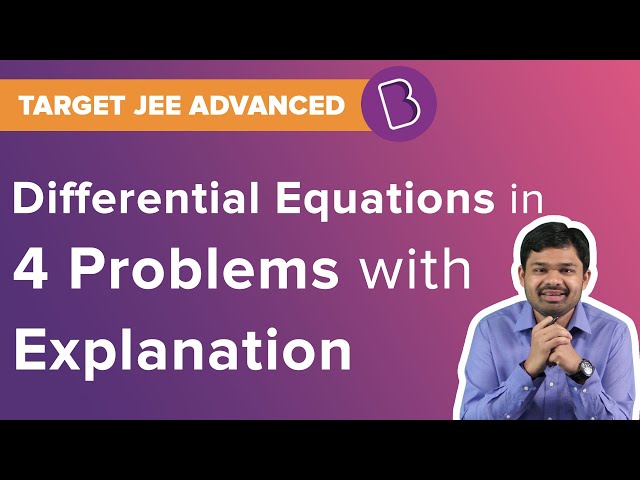a. 0.10
b. 0.20
c. 0.01
d. 0.02
P(𝐴 or 𝐵) = 𝑃(𝐴 ∪ 𝐵) = 1/2
P(exactly one of 𝐴 or 𝐵)= 2/5
⇒ P(𝐴) − 𝑃(𝐴 ∩ 𝐵) + 𝑃(𝐵) − 𝑃(𝐴 ∩ 𝐵) = 2/5
⇒ P(𝐴 ∪ 𝐵) − 𝑃(𝐴 ∩ 𝐵) = 2/5
⇒ P(𝐴 ∩ 𝐵) = 1/10
Answer: (𝑎)
a. is a singleton.
b. is an empty set.
c. contains at least four elements
d. contains exactly two elements.
3𝑥 (3𝑥 − 1) + 2 = |3 𝑥 − 1| + |3𝑥 − 2|
Let 3𝑥 = 𝑡
t(𝑡 − 1) + 2 = |𝑡 − 1| + |𝑡 − 2|
⇒ 𝑡 2 − 𝑡 + 2 = |𝑡 − 1| + |𝑡 − 2|
We plot 𝑡 2 − 𝑡 + 2 and |𝑡 − 1| + |𝑡 − 2|
As 3 𝑥 is always positive, therefore only positive values of 𝑡 will be the solution.

Therefore, we have only one solution.
Answer: (𝑎)
a. 4.01
b. 3.99
c. 3.98
d. 4.02
Mean = 10 ⇒ ∑ 𝑥𝑖/20 = 10 ⇒ ∑ 𝑥𝑖 = 200
Variance = 4 ⇒ ∑ 𝑥𝑖 2/20 − 100 = 4 ⇒ ∑ 𝑥𝑖 2 = 2080
New mean = (200−9+11) / 20 = 202/20 = 10.1
New variance = (2080−81+121)/ 20 − (10.1) 2
= 106 − 102.01 = 3.99
Answer: (𝑏)
a. 1/2
b. – 3/2
c. – 1/2
d. −1
𝑎⃗ = 𝑖̂ − 2𝑗̂ + 𝑘̂
𝑏⃗ = 𝑖̂ − 𝑗̂ + 𝑘̂
𝑏⃗× 𝑐⃗= 𝑏⃗× 𝑎⃗
⇒ 𝑎⃗ × ( 𝑏⃗ × 𝑐⃗ ) = 𝑎⃗× (𝑏⃗× 𝑎⃗)
⇒ (𝑎⃗. 𝑐⃗ ) 𝑏⃗ − (⃗𝑎⃗. 𝑏⃗)𝑐⃗= (𝑎⃗. 𝑎⃗)𝑏⃗ − (𝑎⃗. 𝑏⃗)𝑎⃗
⇒ − (⃗𝑎⃗. 𝑏⃗)𝑐⃗= (𝑎⃗. 𝑎⃗)⃗𝑏⃗ − (𝑎⃗. 𝑏⃗)𝑎⃗
⇒ −4𝑐⃗= 6(𝑖̂− 𝑗̂+ 𝑘̂) − 4(𝑖̂− 2𝑗̂+ 𝑘̂)
⇒ 𝑐⃗ = − 1/2 (𝑖̂ + 𝑗̂ + 𝑘̂)
∴ 𝑏⃗. 𝑐⃗= − ½
Answer: (𝑐)
a. ( 2/5 , 3/5 ] ∪ ( 3/4 , 4/5 )
b. ( 2/5 , 4/5 ]
c. ( 3/5 , 4/5 )
d. ( 2/5 , 1/2 ) ∪ ( 3/5 , 4/5 ]
f(𝑥) = 𝑥[𝑥]/(𝑥2+1)

Answer: (𝑑)
a. 𝛼 + 𝛽 = −30
b. 𝛼 − 𝛽 = −132
c. 𝛼 + 𝛽 = 60
d. 𝛼 − 𝛽 = 60
= 2[6𝐶0𝑥 6 + 6𝐶2𝑥 4 (𝑥2 − 1) + 6𝐶4𝑥 2(𝑥 2 − 1) 2 + 6𝐶6 (𝑥2 − 1)3]
= 2[32𝑥 6 − 48𝑥 4 + 18𝑥 2 − 1]
⇒ 𝛼 = −96, 𝛽 = 36
⇒ 𝛼 − 𝛽 = −132
Answer: (𝑏)
a. 3𝑥 + 4𝑦 = 94
b. 𝑥 + 2𝑦 = 42
c. 2𝑥 + 5𝑦 = 100
d. 𝑥 + 3𝑦 = 58
Vertex of hyperbola is (±𝑎, 0) ≡ (±6, 0) ⇒ 𝑎 = 6
Equation of hyperbola is (𝑥 2/𝑎2) – (𝑦 2 / 𝑏2) = 1
⇒ (𝑥 2/36) – (𝑦 2/𝑏 2) = 1
As 𝑃 (10,16) lies on the parabola.
(100/36) – (256/ 𝑏2) = 1
⇒ 64/36 = 256/𝑏2
⇒ 𝑏2 = 144
Equation of hyperbola becomes (𝑥 2/36) – (𝑦 2/144) = 1
Equation of normal is (𝑎 2𝑥/𝑥1) + (𝑏 2𝑦 /𝑦1) = 𝑎 2 + 𝑏 2
⇒ (36𝑥/10) + (144𝑦/16) = 180
⇒ (𝑥/50) + (𝑦 /20) = 1
⇒ 2𝑥 + 5𝑦 = 100
Answer: (𝑐)
a. 0
b. 1/10
c. – 1/10
d. − 1/5
Applying L’Hospital’s Rule:
=
Answer: (a)
a. 𝑐 2 + 7𝑐 + 6 = 0
b. 𝑐 2 − 6𝑐 + 7 = 0
c. 𝑐 2 − 7𝑐 + 6 = 0
d. 𝑐 2 + 6𝑐 + 7 = 0
For circle, 𝑥 2 + 𝑦 2 = 1
2𝑥 + 2𝑦𝑦 ′ = 0 ⇒ 𝑦 ′ = − 𝑥/y
Slope of tangent to 𝑥 2 + 𝑦 2 = 1 at ( 1/√2 , 1/√2 ) = −1
⇒Slope of tangent to (𝑥 − 3) 2 + 𝑦 2 = 1 is 1 ⇒ 𝑚 = 1
Tangent to (𝑥 − 3) 2 + 𝑦 2 = 1 is 𝑦 = 𝑥 + 𝑐
Perpendicular distance of tangent 𝑦 = 𝑥 + 𝑐 from centre (3, 0) is equal to radius = 1
| (3 + 𝑐)/√2 | = 1
⇒ 𝑐 + 3 = ±√2
⇒ 𝑐2 + 6𝑐 + 9 = 2
⇒ 𝑐2 + 6𝑐 + 7 = 0
Answer: (𝑑)
a. 𝑥 2 + 101𝑥 + 100 = 0
b. 𝑥 2 + 102𝑥 + 101 = 0
c. 𝑥 2 − 102𝑥 + 101 = 0
d. 𝑥 2 − 101𝑥 + 100 = 0
𝛼 = (−1+𝑖√3)/2 = 𝜔
⇒ 𝑎 = (1 + 𝛼)[1 + 𝛼 2 + 𝛼 4 + ⋯ . +𝛼 200]
⇒ 𝑎 = (1 + 𝛼) [ (1 − (𝛼 2 ) 101)/(1 − 𝛼 2) ]
⇒ 𝑎 = [ (1 − (𝜔 2 ) 101 )/(1 – 𝜔) ] = [ (1 – 𝜔)/( 1 – 𝜔) ] = 1
⇒ 𝑏 = 1 + 𝜔 3 + 𝜔 6+. . . . +𝜔300
⇒ 𝑏 = 101
Required equation is 𝑥 2 −102𝑥 + 101 = 0
Answer: (𝑐)
a. (1, −1, 1)
b. (−1, −1, 1)
c. (1, 1, 1)
d. (−1, −1, −1)
Image of point P(1, 2, 3) w.r.t. a plane 𝑎𝑥 + 𝑏𝑦 + 𝑐𝑧 + 𝑑 = 0 is 𝑄 (− 7/3 , − 4/3 , − 1/3 )
Direction ratios of 𝑃𝑄: − 10/3, − 10/3 , − 10/3 = 1, 1, 1
Direction ratios of normal to plane is 1, 1, 1
Mid-point of 𝑃𝑄 lies on the plane
∴ The mid-point of 𝑃𝑄 = (− 2/3 , 1/3 , 4/3 )
∴ Equation of plane is 𝑥 + (2/3) + 𝑦 – (1/3) + 𝑧 – (4/3) = 0
⇒ 𝑥 + 𝑦 + 𝑧 = 1
(1, −1, 1) satisfies the equation of the plane.
Answer: (𝑎)
a. 2
b. 2√2
c. 4√2
d. √2
Given curve: 𝑥 2 + 2𝑥𝑦 − 3𝑦 2 = 0
⇒ 𝑥 2 + 3𝑥𝑦 − 𝑥𝑦 − 3𝑦 2 = 0
⇒ (𝑥 + 3𝑦)(𝑥 − 𝑦) = 0
Equating we get, 𝑥 + 3𝑦 = 0 or 𝑥 − 𝑦 = 0
(2, 2) lies on 𝑥 − 𝑦 = 0
∴ Equation of normal will be 𝑥 + 𝑦 = 𝜆
It passes through (2, 2)
∴ 𝜆 = 4
𝐿 ∶ 𝑥 + 𝑦 = 4
Distance of 𝐿 from the origin = | −4/√2 | = 2√2
Answer: (b)
a. ~(𝑝 ∧ ~𝑞) → (𝑝 ∨ 𝑞)
b. (~𝑝 ∨ ~𝑞) → (𝑝 ∧ 𝑞)
c. 𝑝 ∨ (~𝑞) → (𝑝 ∧ 𝑞)
d. ~(𝑝 ∨ ~𝑞) → (𝑝 ∨ 𝑞)
~(𝑝 ∨ ~𝑞) → (𝑝 ∨ 𝑞)
= (𝑝 ∨ ~𝑞) ∨ (𝑝 ∨ 𝑞)
= (𝑝 ∨ 𝑝) ∨ (𝑞 ∨ ~𝑞)
= 𝑝 ∨ 𝑇
= 𝑇
Answer: (𝑑)
a. 1/6 < I 2 < 1/2
b. 1/8 < I 2 < 1/4
c. 1/9 < I 2 < 1/8
d. 1/16 < I 2 < 1/9
Let
𝑓 ′ (𝑥) = (−(6𝑥 2 − 18𝑥 + 12))/ 2(2𝑥 3 − 9𝑥 2 + 12𝑥 + 4) 3/2 = (−3(𝑥 − 1)(𝑥 − 2))/ (2𝑥 3 − 9𝑥 2 + 12𝑥 + 4) 3/2 ⇒ 𝑓𝑚𝑖𝑛 = 𝑓(1) and 𝑓𝑚𝑎𝑥 = 𝑓(2)
= 1/√9 = 1/3
1/3 < I < 1/√8
⇒ 1/9 < I 2 < 1/8
Answer: (𝑐)
a. 6I − 𝐴
b. 𝐴 − 6I
c. 4I − 𝐴
d. 𝐴 − 4I
If
⇒ 10𝐴 −1 = 𝐴 − 6I
Answer: (𝑏)
a. 31/3
b. 32/3
c. 29/3
d. 34/3
We have 𝑥 2 ≤ 𝑦 ≤ −2𝑥 + 3

For point of intersection of two curves
𝑥 2 + 2𝑥 − 3 = 0
⇒ 𝑥 = −3, 1
⇒
= 32/3 sq. units
Answer: (𝑏)
a. (f(1)−𝑓(𝑐))/ (1−𝑐) = 𝑓′(𝑐)
b. |f(𝑐) − 𝑓(1)| < |𝑓′(𝑐)|
c. |f(𝑐) + 𝑓(1)| < (1 + c)|𝑓 ′ (𝑐)|
d. |f(𝑐) − 𝑓(1)| < (1 − 𝑐)|𝑓′(𝑐)|
𝑆 is set of all functions.
If we consider a constant function, then option 2, 3 and 4 are incorrect.
For option 1:
(f(1) − 𝑓(𝑐))/ (1 – 𝑐) = 𝑓′(𝑐)
This may not be true for f(𝑥) = 𝑥 2
None of the options are correct.
Answer: (Bonus)
a. 𝑥𝑦′′ = 𝑦′
b. x(𝑦′) 2 = 𝑥 + 2𝑦𝑦′
c. x(𝑦 ′ ) 2 = 𝑥 − 2𝑦𝑦′
d. x(𝑦 ′ ) 2 = 2𝑦𝑦 ′ − 𝑥
𝑥 2 = 4(𝑦 + 𝑏) … (1)
Differentiating both the sides w.r.t. 𝑥, we get
⇒ 2𝑥 = 4𝑏𝑦 ′
⇒ 𝑏 = 𝑥/2𝑦′
Putting the value of 𝑏 in (1), we get
⇒ 𝑥 2 = (2𝑥/𝑦′) (𝑦 + (𝑥 /2𝑦′))
⇒ 𝑥 2 = (2𝑥𝑦 /𝑦′ )+ (𝑥 2/ 𝑦′2)
⇒ x(𝑦 ′) 2 = 2𝑦𝑦 ′ + x
Answer: (b)
𝜆𝑥 + 2𝑦 + 2𝑧 = 5
2𝜆𝑥 + 3𝑦 + 5𝑧 = 8
4𝑥 + 𝜆𝑦 + 6𝑧 = 10 has:
a. no solution when 𝜆 = 2
b. infinitely many solutions when 𝜆 = 2
c. no solution when 𝜆 = 8
d. a unique solution when 𝜆 = −8
= 18𝜆 − 5𝜆 2 − 24𝜆 + 40 + 4𝜆 2 − 24
⟹ 𝐷 = −𝜆 2 − 6𝜆 + 16
Now, 𝐷 = 0
⇒ 𝜆 2 + 6𝜆 − 16 = 0 ⇒ 𝜆 = −8 or 2
For 𝜆 = 2
= 40 + 4 − 28 ≠ 0
∴ Equations have no solution for 𝜆 = 2.
Answer: (a)
a.
b. 100
c. 50
d.
𝑇10 = 1/20
𝑇20 = 1/10
𝑇20 − 𝑇10 = 10𝑑
⇒ (1/20) = 10𝑑
𝑑 = 1/200
∴ 𝑎 = 1/200
𝑆200 = (200/2) [2 (1/200) + 199 ( 1/200)]
=
Answer: (𝑑)
Let the co-ordinates of 𝑃 be (𝑡 2, 𝑡)
Equation of tangent at (𝑡 2, 𝑡) is 𝑦 − 𝑡 = (1/2𝑡) (𝑥 − 𝑡 2 )
Therefore, co-ordinates of 𝑄 will be (−𝑡 2, 0)
Area of Δ𝑂𝑃𝑄 = 4
⇒ 𝑡 3 = ±8
⇒ 𝑡 = ±2
⇒ 𝑡 = 2 as 𝑡 > 0
𝑚 = 1/𝑡 = ½
Answer: (0.5)
Let the polynomial be
f(𝑥) = 𝑎𝑥3 + 𝑏𝑥 2 + 𝑐𝑥 + 𝑑
⇒ 𝑓 ′ (𝑥) = 3𝑎𝑥 2 + 2𝑏𝑥 + 𝑐
⇒ 𝑓 ′′(𝑥) = 6𝑎𝑥 + 2𝑏
𝑓 ′′(1) = 0 ⇒ 6𝑎 + 2𝑏 = 0 ⇒ 𝑏 = −3𝑎
𝑓 ′ (−1) = 0 ⇒ 3𝑎 − 2𝑏 + 𝑐 = 0
⇒ 𝑐 = − 9a
f(−1) = 10 ⇒ −𝑎 + 𝑏 − 𝑐 + 𝑑 = 10
⇒ −𝑎 − 3𝑎 + 9𝑎 + 𝑑 = 10
𝑑 = −5𝑎 + 10
f(1) = -6
⇒ 𝑎 + 𝑏 + 𝑐 + 𝑑 = -6
⇒ 𝑎 − 3𝑎 − 9𝑎 − 5𝑎 + 10 = -6
⇒ 𝑎 = 1
∴ 𝑓 ′ (𝑥) = (3𝑥 2 – 6𝑥 – 9
= 3𝑥2 − 2𝑥 − 3
For 𝑓 ′ (𝑥) = 0 ⇒ 𝑥 2 − 2𝑥 − 3 = 0 ⇒ 𝑥 = 3, −1
Minima exists at 𝑥 = 3
Answer: (3)
⇒ tan 𝛼 = 1/7
⇒ (√2 sin𝛽) /√2 = 1 √10
⇒ sin𝛽 = 1 √10
⇒ tan 𝛽 = 1/3
tan 2𝛽 = (2 tan 𝛽)/ (1 − tan2 𝛽) = (2/3)/(1 – 1/9) = 3/4
tan(𝛼 + 2𝛽) = (tan 𝛼 + tan 2𝛽)/( 1 − tan 𝛼 tan 2𝛽)
= (1/7 + ¾)/(1 – (1/7) × (3/4)) = 1
Answer: (1)
Word “EXAMINATION” consists of 2𝐴, 2𝐼, 2𝑁, 𝐸, 𝑋, 𝑀, 𝑇,
Case I: All different letters are selected
Number of words formed = 8𝐶 4 × 4! = 1680
Case II: 2 letters are same and 2 are different Number of words formed = 3𝐶1 × 7𝐶 2 × (4!/ 2!) = 756
Case III: 2 pair of letters are same
Number of words formed = 3𝐶 2 × 4!/(2!×2!) = 18
Total number of words formed = 1680 + 756 + 18 = 2454
Answer: (2454)
= 504
Answer: (504)
Video Lessons – January 8 Shift 2 Maths




JEE Main 2020 Maths Paper With Solutions Jan 8 Shift 2















Comments